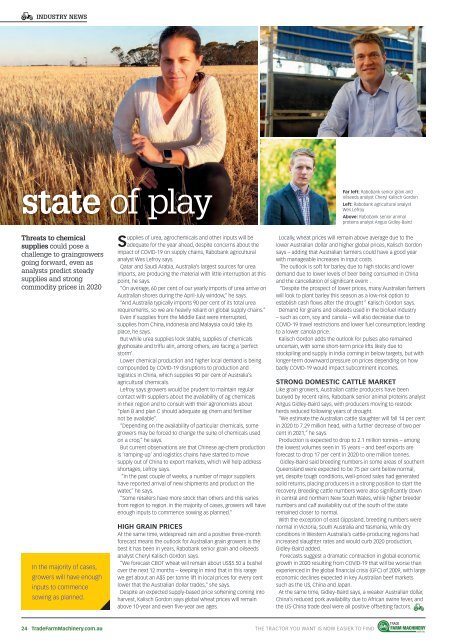Create successful ePaper yourself
Turn your PDF publications into a flip-book with our unique Google optimized e-Paper software.
INDUSTRY NEWS<br />
state of play<br />
Far left: Rabobank senior grain and<br />
oilseeds analyst Cheryl Kalisch Gordon<br />
Left: Rabobank agricultural analyst<br />
Wes Lefroy<br />
Above: Rabobank senior animal<br />
proteins analyst Angus Gidley-Baird<br />
Threats to chemical<br />
supplies could pose a<br />
challenge to graingrowers<br />
going forward, even as<br />
analysts predict steady<br />
supplies and strong<br />
commodity prices in 2020<br />
In the majority of cases,<br />
growers will have enough<br />
inputs to commence<br />
sowing as planned.<br />
Supplies of urea, agrochemicals and other inputs will be<br />
adequate for the year ahead, despite concerns about the<br />
impact of COVID-19 on supply chains, Rabobank agricultural<br />
analyst Wes Lefroy says.<br />
Qatar and Saudi Arabia, Australia’s largest sources for urea<br />
imports, are producing the material with little interruption at this<br />
point, he says.<br />
“On average, 60 per cent of our yearly imports of urea arrive on<br />
Australian shores during the April-July window,” he says.<br />
“And Australia typically imports 90 per cent of its total urea<br />
requirements, so we are heavily reliant on global supply chains.”<br />
Even if supplies from the Middle East were interrupted,<br />
supplies from China, Indonesia and Malaysia could take its<br />
place, he says.<br />
But while urea supplies look stable, supplies of chemicals<br />
glyphosate and triflu alin, among others, are facing a ‘perfect<br />
storm’.<br />
Lower chemical production and higher local demand is being<br />
compounded by COVID-19 disruptions to production and<br />
logistics in China, which supplies 90 per cent of Australia’s<br />
agricultural chemicals.<br />
Lefroy says growers would be prudent to maintain regular<br />
contact with suppliers about the availability of ag chemicals<br />
in their region and to consult with their agronomists about<br />
“plan B and plan C should adequate ag chem and fertiliser<br />
not be available”.<br />
“Depending on the availability of particular chemicals, some<br />
growers may be forced to change the suite of chemicals used<br />
on a crop,” he says.<br />
But current observations are that Chinese ag-chem production<br />
is ‘ramping-up’ and logistics chains have started to move<br />
supply out of China to export markets, which will help address<br />
shortages, Lefroy says.<br />
“In the past couple of weeks, a number of major suppliers<br />
have reported arrival of new shipments and product on the<br />
water,” he says.<br />
“Some retailers have more stock than others and this varies<br />
from region to region. In the majority of cases, growers will have<br />
enough inputs to commence sowing as planned.”<br />
HIGH GRAIN PRICES<br />
At the same time, widespread rain and a positive three-month<br />
forecast means the outlook for Australian grain growers is the<br />
best it has been in years, Rabobank senior grain and oilseeds<br />
analyst Cheryl Kalisch Gordon says.<br />
“We forecast CBOT wheat will remain about US$5.50 a bushel<br />
over the next 12 months – keeping in mind that in this range<br />
we get about an A$5 per tonne lift in local prices for every cent<br />
lower that the Australian dollar trades,” she says.<br />
Despite an expected supply-based price softening coming into<br />
harvest, Kalisch Gordon says global wheat prices will remain<br />
above 10-year and even five-year ave ages.<br />
Locally, wheat prices will remain above average due to the<br />
lower Australian dollar and higher global prices, Kalisch Gordon<br />
says – adding that Australian farmers could have a good year<br />
with manageable increases in input costs.<br />
The outlook is soft for barley, due to high stocks and lower<br />
demand due to lower levels of beer being consumed in China<br />
and the cancellation of significant event .<br />
“Despite the prospect of lower prices, many Australian farmers<br />
will look to plant barley this season as a low-risk option to<br />
establish cash flows after the drought ” Kalisch Gordon says.<br />
Demand for grains and oilseeds used in the biofuel industry<br />
– such as corn, soy and canola – will also decrease due to<br />
COVID-19 travel restrictions and lower fuel consumption; leading<br />
to a lower canola price.<br />
Kalisch Gordon adds the outlook for pulses also remained<br />
uncertain, with some short-term price lifts likely due to<br />
stockpiling and supply in India coming in below targets, but with<br />
longer-term downward pressure on prices depending on how<br />
badly COVID-19 would impact subcontinent incomes.<br />
STRONG DOMESTIC CATTLE MARKET<br />
Like grain growers, Australian cattle producers have been<br />
buoyed by recent rains, Rabobank senior animal proteins analyst<br />
Angus Gidley-Baird says, with producers moving to restock<br />
herds reduced following years of drought.<br />
“We estimate the Australian cattle slaughter will fall 14 per cent<br />
in 2020 to 7.29 million head, with a further decrease of two per<br />
cent in 2021,” he says.<br />
Production is expected to drop to 2.1 million tonnes – among<br />
the lowest volumes seen in 15 years – and beef exports are<br />
forecast to drop 17 per cent in 2020 to one million tonnes.<br />
Gidley-Baird said breeding numbers in some areas of southern<br />
Queensland were expected to be 75 per cent below normal,<br />
yet, despite tough conditions, well-priced sales had generated<br />
solid returns, placing producers in a strong position to start the<br />
recovery. Breeding cattle numbers were also significantly down<br />
in central and northern New South Wales, while higher breeder<br />
numbers and calf availability out of the south of the state<br />
remained closer to normal.<br />
With the exception of east Gippsland, breeding numbers were<br />
normal in Victoria, South Australia and Tasmania, while dry<br />
conditions in Western Australia’s cattle-producing regions had<br />
increased slaughter rates and would curb 2020 production,<br />
Gidley-Baird added.<br />
Forecasts suggest a dramatic contraction in global economic<br />
growth in 2020 resulting from COVID-19 that will be worse than<br />
experienced in the global financial crisis (GFC) of 2009, with large<br />
economic declines expected in key Australian beef markets<br />
such as the US, China and Japan.<br />
At the same time, Gidley-Baird says, a weaker Australian dollar,<br />
China’s reduced pork availability due to African swine fever, and<br />
the US-China trade deal were all positive offsetting factors.<br />
24 Trade<strong>Farm</strong><strong>Machinery</strong>.com.au THE TRACTOR YOU WANT IS NOW EASIER TO FIND

















